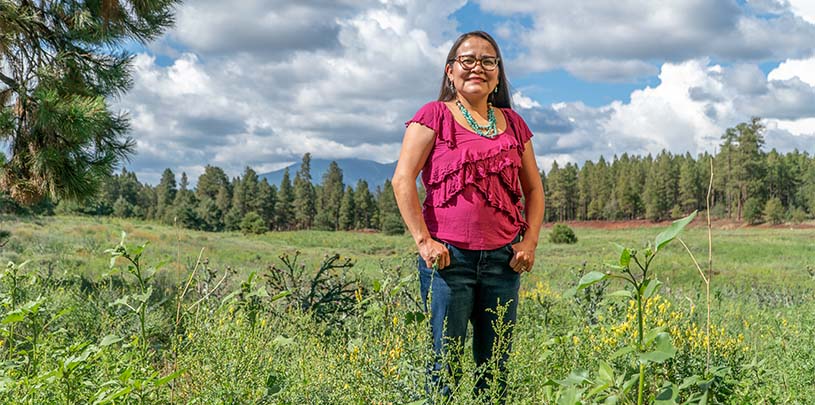
 by Sarana Riggs, Grand Canyon Manager
by Sarana Riggs, Grand Canyon Manager
Growing up on Black Mesa without running water, Dr. Karletta Chief made regular trips to the local community well to fill up 10-gallon galvanized steel containers. Her family had relatively easier access to water than most — they only had to drive 5 miles to the well, while others they knew traveled as far as 50 miles to fill up water tanks.
The first time Dr. Chief turned on a shower, she was a freshman at Stanford University.
“Here I am, a young woman from the Navajo Nation, growing up without electricity or running water, and suddenly having this experience of the luxury of turning on the light switch and taking a shower. It took some time to get used to,” she admits.
Now, a hydrologist and associate professor and extension specialist at the University of Arizona, Dr. Chief works with Native American communities to develop and refine innovative off-grid technologies that provide water, energy, and food security for people living remotely.
“I choose to work with Indigenous communities because I have always wanted to give back to my people,” she says.
Dr. Chief’s upbring was filled with beauty, blessings, and traditional Diné (Navajo) livelihoods. Rich in culture, Black Mesa also happened to be rich in coal. Her family lived close to the Black Mesa Coal Mine — so close, in fact, that a spark from the mine’s operations caused her grandmother’s corral to catch on fire. Her grandfather’s family lost a whole herd of sheep when the animals drank contaminated water. Dr. Chief started asking, “Why do we not have electricity? Yet nearby, there’s a coal mine pulverizing coal and sending it off to produce energy for cities like Los Angeles, Las Vegas, and Phoenix?”
Those questions, plus a love of math, chemistry, and physics, set Dr. Chief on her path to becoming an environmental engineer. She got her Ph.D. in hydrology and water resources from the University of Arizona, where she continues her work today.
“In my work, I believe that I am not only using my education as a scientist, but also learning, valuing, and centering Indigenous priorities so that the community’s challenges are addressed in a culturally sensitive way.”
She leads a National Science Foundation funded training program to teach graduate students how to work with Indigenous communities to address food, energy, and water insecurities. Her “Indigenous Food, Energy and Water Security and Sovereignty” team created a water treatment system that sits on a trailer bed, can be moved anywhere, is powered by solar panels, and results in safe drinking water. The idea is evolving over time, in collaboration with community partners.
“I know some people might think, ‘why don’t you just move to the city where there are resources?’ But my grandmother, my parents, they don’t want to move to the city. They’d rather live off-grid, in their ancestral homelands and continue their way of life and their culture,” Dr. Chief explains. “We are proud of our culture, we have a rich history, and we have a lot of knowledge to contribute to sustainable living.”
According to Dr. Chief, climate change has a huge impact on water resources of Native American communities in the United States. The Pacific Northwest tribes are dealing with altered salmon spawning cycles. Flooding has inundated Midwest tribes’ sacred staple of wild rice. Alaska tribes are facing water quality changes because of how fast the glaciers are melting.
But those are just physical examples of how climate change is impacting Native American communities, Dr. Chief says.
“There’s a big spiritual impact as well. Water is sacred and is important to a lot of cultural practices.”
Here in the Southwest, Dr. Chief has seen substantial declines in rain and snow.
“I remember as a kid, being able to go to different sites on my grandmother’s land and see water run from the crevasses of these canyons.”
Water doesn’t flow from the crevasses today.
In many communities on the Navajo Nation, the water table of alluvial aquifers has dropped below the intakes of wells. That leaves communities high and dry, a big problem when you’re already driving 50 miles to fill up your water jugs.
The Navajo Nation primarily relies on groundwater, as most communities don’t have access to surface water for domestic drinking water, says Dr. Chief. She points to the Little Colorado River as an example. It cuts right through the Navajo Nation, is very dependent on precipitation, and is very flashy.
“They have no access to this river that goes through their land. And I think that’s a major challenge for communities that are facing drought and water shortages today.”
Dr. Chief’s biggest concern is our ability to adapt to the changing climate. But she knows, firsthand, how resilient Indigenous communities are.
“Our communities have gone through changes in climate through a variety of sustainable ways of living, ways of knowing. We need to go back to those sustainable ways, and use that traditional knowledge to adapt to climate change.”
The Colorado River below Glen Canyon Dam is heating up. Find out why.
Read MoreGroundwater pumping at a uranium mine near the Grand Canyon will affect the canyon's springs, scientists says.
Read MoreArizona Governor Katie Hobbs is the latest elected official to call for an environmental review of Pinyon Plain uranium mine.
Read More